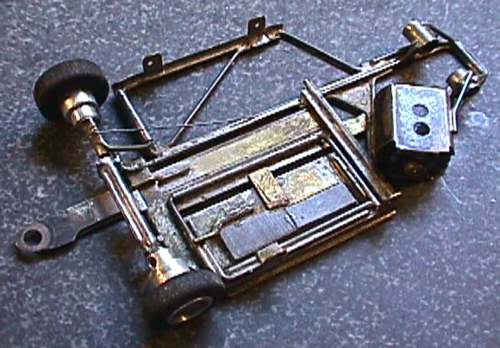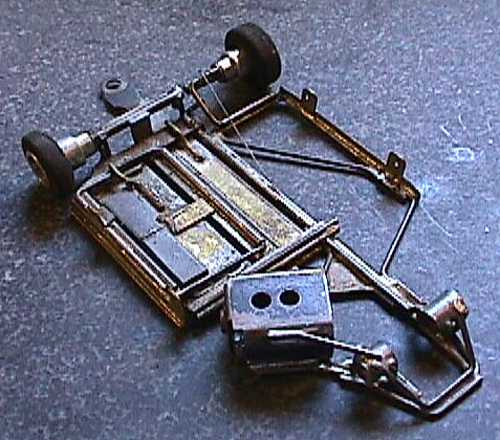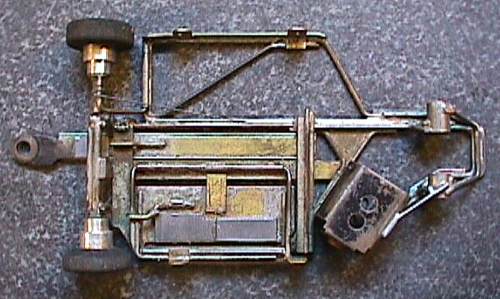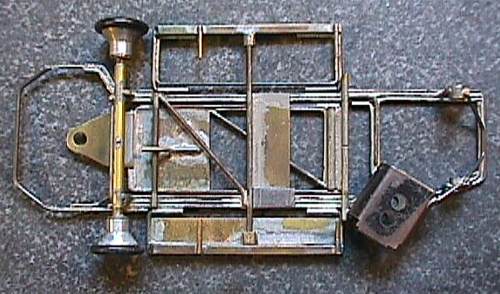Reader's Gallery 5 |
Cheater Wells Oval Specials 1, 2 and 3
I received an e-mail from Atlanta area slot racer Greg "Cheater" Wells, saying in part:
"Attached are some pictures of chassis I built about 12 or 13 years ago for
hardbody oval racing. Cars had to weight 4-1/2 ounces, so these are not
lightweight chassis. One feature of two of these chassis is a reverse floppy pan,
that shifts weight opposite of the direction of body roll. I can almost guarantee,
you will not have anyone else contribute pics of chassis that look anything like these."
Indeed! I knew that oval racers scratchbuilt asymmetric chassis, but these are definitely
out there! In another article,
I had pessimistically predicted that there are
not enough young solderers out there to guarantee that good ideas get scratchbuilt
and tried. Greg may prove me wrong!
I'll let him explain his creations in his own words, below. Thanks for the contributions
to the Reader's Gallery, Greg!
Page 1 |
Page 2 |
Page 3 |
Page 4
|

Cheater Wells
Oval Special 1
"Before you start snickering, please remember that these three chassis were built over a
decade ago. (Drop arms are a thing of the past, you know.) That being said,
for the day, a couple of them worked very well.
This was the first weird oval chassis I made and it went through a large
number of modifications to end up in this final form.
|

"The motor can was soldered in place as part of the chassis (monocoque!),
which required building the motors in place, a real pain. This chassis was
built for 3-inch width, 1/8-inch axles, and tall (7/8-inch?) tires. The
inner tire had to be beveled a lot to clear the can. The can is also dimpled
on the back side, but this is not visible.
A later mod was to convert the Right Front (RF)
wheel to leading arm suspension, which worked well. As the chassis rolls to
the outside of the turn, the RF wheel folds up and away. Clearance under the
RH fixed pan was greater than the 1/16-inch under the rest of the chassis,
to accommodate a fair amount of roll before the chassis hit the track.
|

"This was the first chassis to feature a reverse rising rate LH floppy, the
action of which is hard to describe but which will be shown better on a
later chassis. Basically, the LH pan is two parts: the heavy brass plate
lower pan which is hinged along the LH outer side of the chassis. Above this
is the top "pan", which carries a body mounting channel on its LH outer edge
but which is otherwise just a couple of arms of piano wire. It is hinged
along the chassis centerline.
When the car enters the LH turns, the body
wants to roll to the right, lifting the outer LH body mounting channel of
the top pan. The S-shaped hook on the front of the lower pan is lifted by
the upward movement of the top pan's front arm. But since the lower pan is
hinged along the LH side of the chassis, what this accomplishes is to
transfer weight opposite the direction of the body roll. Confusing, I know,
but the action will be clearer in a photo on the next page.
This chassis worked pretty well but the high motor angle was really hard on
the motor. It tended to twist the comms loose from the motor shafts, breaking the wires.
|

Cheater Wells
Oval Special 2
"This next design was built for 3-1/4-inch width, 3/32-inch axles, and
smaller tires, which allowed for less motor angle.
Note the offset of the main piano wire rails and the fact that there are
three LH rails versus only two RH rails. Pans are simple floppies, with
outer rails of square tubing but the RH side is hollow and the LH side is
filled with rod. Motor can is again part of the chassis.
This car would roll over on one side if placed on its top and it was the
most successful of the three chassis shown here. The car was never beaten
the few times it was raced.
|
|